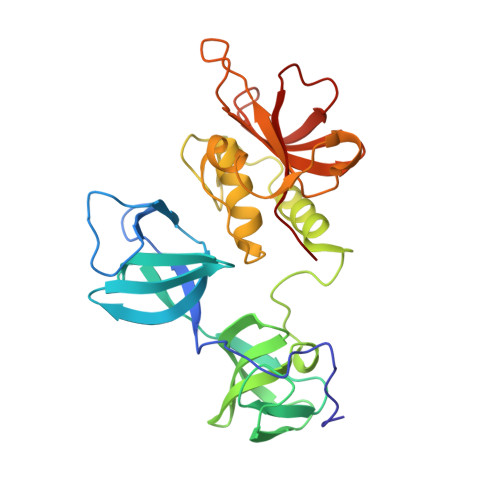The ProtozoanTrichomonas vaginalisTargets Bacteria with Laterally Acquired NlpC/P60 Peptidoglycan Hydrolases.
Pinheiro, J., Biboy, J., Vollmer, W., Hirt, R.P., Keown, J.R., Artuyants, A., Black, M.M., Goldstone, D.C., Simoes-Barbosa, A.(2018) mBio 9
- PubMed: 30538181
- DOI: https://doi.org/10.1128/mBio.01784-18
- Primary Citation of Related Structures:
6BIM, 6BIO, 6BIQ - PubMed Abstract:
The human eukaryotic pathogen Trichomonas vaginalis causes trichomoniasis, a prevalent sexually transmitted infection. This extracellular protozoan is intimately associated with the human vaginal mucosa and microbiota, but key aspects of the complex interactions between the parasite and the vaginal bacteria remain elusive. We report that T. vaginalis has acquired, by lateral gene transfer from bacteria, genes encoding peptidoglycan hydrolases of the NlpC/P60 family. Two of the T. vaginalis enzymes were active against bacterial peptidoglycan, retaining the active-site fold and specificity as dl-endopeptidases. The endogenous NlpC/P60 genes are transcriptionally upregulated in T. vaginalis in the presence of bacteria. The overexpression of an exogenous copy enables the parasite to outcompete bacteria from mixed cultures, consistent with the biochemical activity of the enzyme. Our study results highlight the relevance of the interactions of this eukaryotic pathogen with bacteria, a poorly understood aspect of the biology of this important human parasite. IMPORTANCE Trichomonas vaginalis is a parasitic protozoan of the human urogenital tract that causes trichomoniasis, a very common sexually transmitted disease. Despite residing extracellularly and in close association with the vaginal bacteria (i.e., the microbiota), very little is known about the nature of the parasite-bacterium interactions. Our study showed that this parasite had acquired genes from bacteria which retained their original function. They produce active enzymes capable of degrading peptidoglycan, a unique polymer of the bacterial cell envelope, helping the parasite to outcompete bacteria in mixed cultures. This study was the first to show that a laterally acquired group of genes enables a eukaryotic mucosal pathogen to control bacterial population. We highlight the importance of understanding the interactions between pathogens and microbiota, as the outcomes of these interactions are increasingly understood to have important implications on health and disease.
Organizational Affiliation:
School of Biological Sciences, University of Auckland, Auckland, New Zealand.














